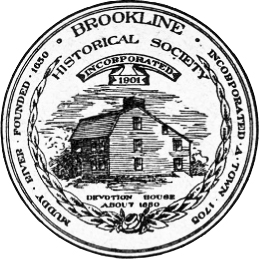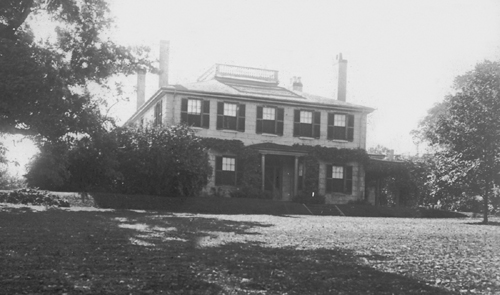
PROCEEDINGS
OF THE
BROOKLINE HISTORICAL SOCIETY
AT THE
ANNUAL MEETING, MARCH 20, 1949
SPRING MEETING, MAY 17, 1949
BROOKLINE, MASS.
PUBLISHED BY THE SOCIETY
1949
OF THE
BROOKLINE HISTORICAL SOCIETY
AT THE
ANNUAL MEETING, MARCH 20, 1949
SPRING MEETING, MAY 17, 1949
BROOKLINE, MASS.
PUBLISHED BY THE SOCIETY
1949
BY DR. WALTER S. BURRAGE
The land on which this house stands was part of one of the sixteen original grants initiated by the selectmen of the town of Boston in 1636. Included among the names of the six most prominent owners of these properties was that of Thomas Oliver. He was allotted 175 acres of this land, roughly triangular in shape and with its apex near the present Brookline Village and its northwestern boundary on this side of Walnut Street. Warren Street was probably its southern limit. The date of this acquisition is doubtful but is listed on the Muddy River allotment map in Curtis' "History of Brookline" as January 8, 1638. In all events, it preceded the so-called wholesale distribution of great allotments on June 8 of that year. Incidentally it may not interest my audience, but it is of some encouragement to your speaker that Thomas Oliver was a surgeon and that, in spite of this, he was at the time of his death at ninety a "lively pattern of old age."
In 1650 this land was acquired by John White and was subsequently owned in succeeding generations by Benjamin, Edward and again Benjamin White. It went, at the latter's death in 1790, to his two sons, Thomas and Oliver who, in turn, sold it to John Tappan. Tappan and his brother, Lewis, were architects who had come over from England not long before and who had collaborated in the building of several stone houses in Brookline, namely the Sewall house, the Arthur Blake house and the little stone schoolhouse known as Pierce Hall. The granite was secured at the Rockport quarries; was loaded on scows and brought by water to Boston. This house was said to 'have been the one hundredth house built in the town of Brookline. The general era of its building was sometimes called the "Brookline Old Stone Age."
Dr. Pierce's manuscript notes state that John Tappan moved in here on July 11, 1822. He did not remain long, however, but was succeeded by William Ropes in. 1827 and then, in 1829, by Samuel Philbrick. It is with this family that 182 Walnut Street is particularly identified, historically speaking.
Samuel Philbrick held various town offices and was well known and respected. He was a pioneer abolitionist, which took great courage in the eighteen thirties and forties when the anti-slavery movement was very unpopular in New England. An intimate friend of Garrison, Phillips and Theodore Parker, Mr. Philbrick was likewise in touch with anti-slavery people throughout the country. At the Philbricks' suggestion, the Grimke sisters, young and wealthy daughters of Judge Grimke of South Carolina, spent the winter of 1836-37 in this house to acquaint the people of the North with the danger which was even then threatening the nation. Their first audience consisted of Brookline ladies assembled in these parlors through invitations sent out by the Philbricks to friends and acquaintances. Public indignation against anti-slavery ran so high at the time that it would have been impossible to have obtained the Town Hall or one of the churches for this purpose. There was one exception to the feminine composition of the audience, however. That was the presence of John Greenleaf Whittier who was secreted in the coat closet which used to stand at the foot of the stairs. From this vantage point he was able to hear and observe the speaker but whether his concealment was to save the latter's embarrassment or his own has not been recorded.
During the winter of the Grimkes' visit Mrs. Philbrick was told of a free colored woman living in Boston where she was struggling to support herself and her child. The result was that a little ten year old colored girl was taken into this house to be made useful and comfortably provided for. On the Sunday after her arrival she was taken to the Unitarian Church with the Philbricks and seated in their own pew. Mr. Philbrick had already incurred much hard feeling by identifying himself with the hated abolitionists. A committee of the society waited upon him before another Sunday came around and he was requested - if he must bring the child to church, to keep peace among the congregation by seating her in the gallery where she belonged. This Mr. Philbrick politely but firmly declined to do. The following Sunday all eyes were focused on the Philbrick pew and sure enough there she was again. The committee returned to the attack the following day but on this occasion Mr. Philbrick told his visitors that if the little colored girl was not good enough to be received in God's House, neither was he - and he never entered the church again.
The Philbrick house was one of the principal stations on the "underground railroad" during this period. The celebrated William and Ellen Crafts were concealed in one of the back rooms here for days while the United States marshal and his men were searching Boston for them. When the excitement had somewhat subsided, Theodore Parker and a friend called for the fugitives in a carriage one night and started them on their way to Canada. Samuel Philbrick died in 1859 leaving his house and place to his son, Edward, to whom he predicted "you will live to see a war over this slavery business." Edward Philbrick married Helen Winsor of Brookline and they lived here for many years. Edward was a well known engineer. It is said that when the town was puzzled about its water supply or when the question was merely that of replacing a bridge, Edward was always on the committee. After Edward's death, Mrs. Philbrick's mother and her brother and sister made their home with her until Mrs. Philbrick's death.
In the summer of 1922 - 27 years ago and just 100 years after John Tappan first moved in-the Burrages took over. The family then consisted of my mother and father, Dr. and Mrs. Walter S. Burrage, my grandmother, Mrs. Sarah Alden Swan, my sister Sally and myself. A few minor changes were made with our acquisition of the property but essentially the house was as it had been for several generations with four main high ceilinged rooms on both first and second floors of the old stone mansion and a wooden ell consisting of kitchen, laundry and five bedrooms to the southwest.
With my marriage and departure in 1934 and with Father's death the following year the house became too large for its remaining occupants. In 1938 what might be called the second generation of Burrages took over. For the first time in many years the place is now infested with children; five Burrages under fourteen and the garage not only filled with cars but with bicycles, tricycles, baby carriages, playpens and sleds. From the standpoint of the old Philbrick House there is some question as to the truth of the saying, "The first hundred years are the hardest."
